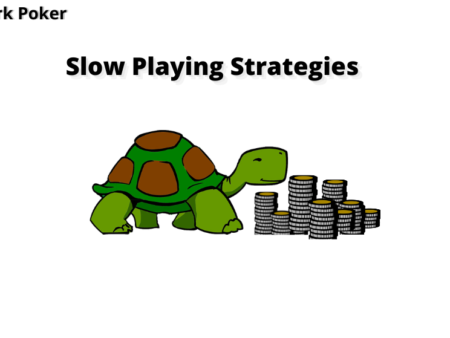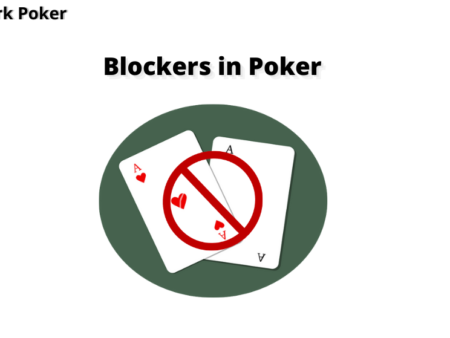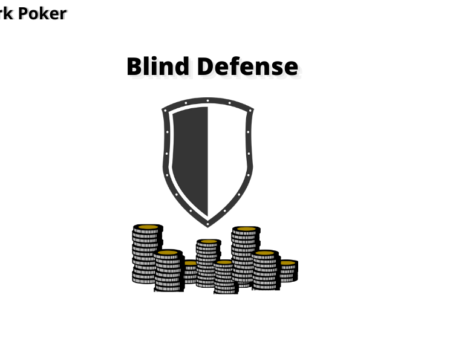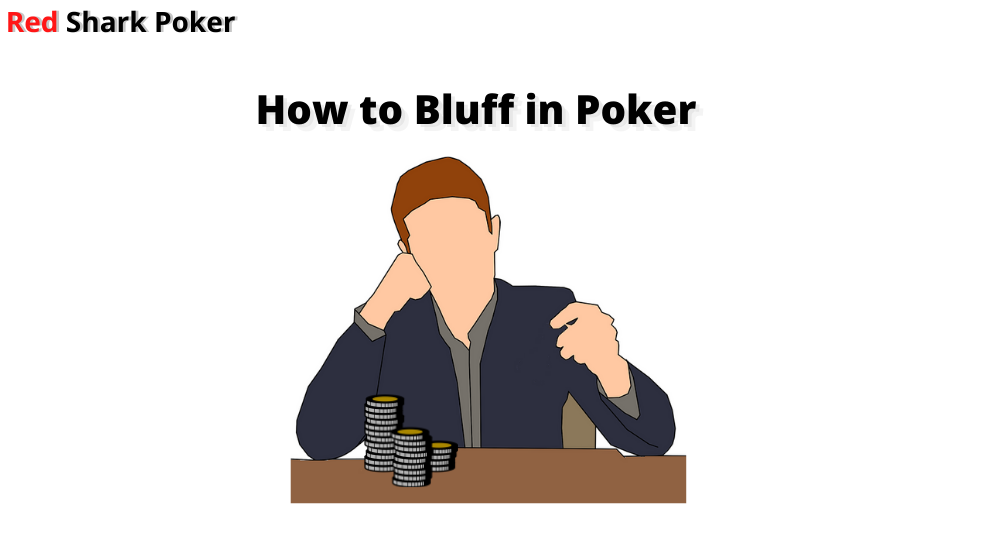
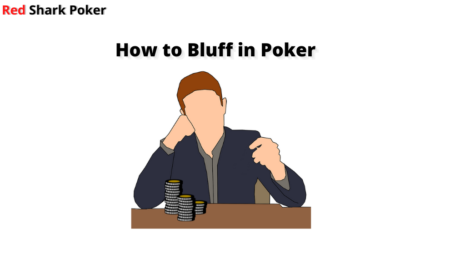
“You will never know my hand until the showdown.”
You can assume, predict or even accurately pinpoint my hand, but you will never know my exact hand before the showdown. This aspect of the game creates the scope for bluffing in poker. If I bet and you fold, you will never know what hand I held (unless I show my hand).
Let’s say you hold K♠ 9♥, and the river reads 10♦ 5♥ J♣ 4♦ K♦. You have a top pair and bet 1/2 the pot, but I go all-in. You sense that I have completed my flush draw. You assume that I have the best hand and decide to fold. But the question is:
- Did I really have the best hand?
- Or did I deceive you by representing a flush with my all-in move?
If I had the best hand, then you saved money. But, if I did not have the best hand and tricked you into thinking that I had the best hand, then I bluffed in poker!
As you can see, poker bluffing is a deceptive move where I made a bet or raised to represent a strong hand. If I can force you to fold, I can win the pot even while holding a worse hand. This tricky move can help you win pots when you have less or zero chances of winning.
What is Poker Bluffing?
Poker bluffing is an advanced move where you represent the best hand by betting, raising or re-raising to force your opponent to fold a better hand than yours. As you do not hold the best hand, the objective of bluffing is to win the pot right away. You are not betting or raising to build the pot but to force your opponent to fold his hand.
An Example of Poker Bluffing
A player from Under the Gun raises to 2X big blind, and you call from the button with 4♠ 5♠. Everyone else folds.
Flop: K♦ 6♥ 7♦
UTG bets 1/3 of the pot. You decide to call as you have an open-ended straight with 8 outs.
Turn: K♦ 6♥ 7♦ 2♣
UTG bets 1/3 of the pot again. It is quite clear that the villain holds a King pair as a King is well within his range as a preflop raiser. As you still have 8 outs, you decide to call.
River: K♦ 6♥ 7♦ 2♣ J♦
UTG checks. You have not completed your straight draw, but you see an opportunity to bluff after the villain has checked. There are three diamonds on the board. If you bet to represent a flush, you can force your opponent to fold his better hand.
You bet 2X the pot, and your opponent folds.
If you had also checked after your opponent checked, you would have lost at the showdown. But you bluffed by representing a flush with a big bet. Thus, poker bluffing can help you win pots even with worse hands.
Isn’t this tricky move of poker bluffing awesome? Let’s know more about this beautiful art of poker bluffing in detail.
Types of Poker Bluffs
Bluffing in poker can be categorized into three types. Let us look at the three types of poker bluffs in detail.
Quick Poker Bluffs
Quick poker bluffs involve betting small amounts to win relatively small to medium-sized pots. They are the least risky bluffs as you are betting a small amount to win a slightly profitable reward. One of the common examples of quick poker bluffs is betting small on a scary flop to make your opponent fold.
For example, you are on the button with 6♠ 7♠ and limp in along with two other players.
Your Hand: 6♠ 7♠
Flop: Q♠ Q♥ 2♣
Both the opponents check. Now you have a chance to pull off a quick bluff. As none of your opponents had raised preflop, it is unlikely that they hold a queen. When they checked on the flop, they seem uninterested. So, if you make a small bet, the chances are that they might fold, and you can win with a quick bluff. If you face a check-raise, you can fold right away. So, with a small bet, you are taking a small risk to win a relatively small to a medium pot.
Semi-Bluff
You should always have some equity if you decide to bluff. If your opponent calls, your hand can become stronger if any of the outs hit the board on the later streets. This is where the concept of semi-bluff comes into play. Semi-bluffing is betting or raising with a hand which is not the best hand on the current street but has the potentiality of becoming the best hand on the later streets.
The most common examples are betting with a flush draw or a straight draw. If you have not completed your draw, you can still win the pot right away by bluffing. However, if your opponent calls and your out hits on the next street, you will have the best hand.
For example, you are on the button with A♠ 2♠ and call UTG’s raise on the preflop.
Flop: J♠ 7♥ 9♠
UTG checks on the flop. Now you have the chance to semi-bluff. As your opponent checked, he might not have connected with the flop. If you bet here and make your opponent fold, you will win the pot. However, if your opponent calls your bet, you still have 9 outs to make a flush on the later streets.
Read: Complete Guide on Semi-Bluffing
Pure Bluff
If you bet with zero equity (no chances of winning) and still make your opponent fold, you win the pot with a pure poker bluff. In order to execute a pure bluff, you need to have a very good read on your opponent. As you cannot win the pot at showdown, the only way to win would be to make your opponent fold. So, it depends on how likely your opponent is going to fold to your bet. You need to be confident enough to know that your opponent will fold; otherwise, it can turn out to be a disaster. For example, on a board like 3♣ 4♦ 8♠ 5♥ 5♠, you have zero equity with a hand like 7♠ 9♠. If you know that your opponent is a very tight player who plays with only broadways and pairs, you can bet to represent a straight, trips or a full house and win the pot with a pure bluff.
Poker Bluffing looks like fun, but it is no child’s play. You must consider a lot of factors before deciding to bluff. Let us look at each of the factors that play an important role in executing the perfect poker bluff.
Know Your Opponent Before You Bluff
The most important factor to consider before poker bluffing is to know how likely is your opponent is going to fold. When you bet, you are not looking to build the pot. Instead, you are looking to win the pot right away by forcing your opponent to fold. You should bluff in poker only when you are confident that your opponent will fold. So, you must know your opponent well before bluffing in poker.
Type of Opponent
It is important to assess the type of your opponent before you decide to bluff in poker. Is your opponent playing tight, or is he playing loose?
Against a Tight Opponent: It is easier to force a tight opponent to fold on a wet board with no high cards. If a tight opponent raises on the preflop, you can expect him to have aces, kings, queens and other broadways. If the board reads 5♥ 6♣ 7♠ 2♦, you can bluff as it is highly improbable for a tight opponent to have these cards. On a wet board like this, you can expect a tight opponent to fold.
Against a Loose Opponent: It is comparatively difficult to force a loose opponent to fold, especially if he is a loose-passive player (fish). Such players have a tendency to call any bet or raise, and they are likely to catch your poker bluff if the board improves for them on later streets. Loose-aggressive players have a tendency to raise more often. If you re-raise, you will probably be called by them.
Opponent’s Level of Intelligence
Another important consideration to make is to know whether your opponent is an intelligent or dumb player. Remember, it is easier to bluff an intelligent player as he is capable of understanding what you are trying to represent. If you are up against a dumb player who can’t understand that you are representing a completed draw like an inside-straight, you are most likely to be called. Look out for the following clues in your opponent’s game to decide his level of intelligence:
- Is your opponent chasing his draws with tough pot odds?
- Is your opponent limping too much from UTG?
- Is your opponent calling on four flush boards?
- Is your opponent calling on paired boards?
- Is your opponent tilting after losing a big pot?
All these questions help you to decide how intelligent your opponent is. Never bluff too much against a dumb player as you are most likely to be called.
Number of Opponents
The success of your poker bluff is directly related to the number of opponents who enter the pot. If multiple opponents call your preflop bet, it is quite difficult to force all the opponents to fold on a bet or raise post-flop. The possibility of pulling off a successful bluff drops drastically, as any of the opponents might call. So, it is best to bluff in poker against a single opponent.
Stack Size Comparison
Always compare your stack size with your opponent’s stack. If you have a short stack, it is difficult to make a big-stacked opponent fold, even if you go all-in. For example, if you have a stack of 7 big blinds and your opponent has a stack of 60 big blinds, you can’t expect your opponent to fold. If you go all-in, you are most likely to be called. Similarly, if you have a big stack size, say 60 big blinds, and your opponent has a stack of 5 big blinds, your opponent will most likely call, even if you go all-in.
Bet Sizing
A good bet sizing is crucial in determining the success of your poker bluffs. The bet sizing is directly related to the type of opponent you are facing. If you have a good read on your opponent and are confident that he is most likely to fold, a small bet can do the job. Tight players usually fold to small to half-pot size bet if the board is not within their range. However, you will need to make a pot-size bet or an overbet for a fish to fold on a scary board. Bet sizing depends a lot on the game history you have against your opponent. When you don’t play, observe which opponent folds to what type of bet sizing. Experience is the key to understanding how much you need to bet for a particular opponent to fold.
Evaluate Your Table Image Before Bluffing
Poker is a game of observation. You observe your opponents, and your opponents observe your playing style as well. So, your table image plays a vital role in determining how likely your opponent will fold to your bet or raise.
Tight Image: If you are playing a tight-aggressive or a tight-passive style, it is easier to force your opponent to fold on dry flops with high cards. Your table image will help you to capitalize on your poker bluffing. For example, if you open raise with K♦ Q♦ on the preflop, you can bluff on a dry flop like A♠ 5♥ 10♦. As you are playing tight, an Ace is well within your range. You can expect your opponent to fold if you bet here.
Loose Image: It is difficult to force your opponent to fold if you are playing a loose-passive or a loose-aggressive style. As you have entered the pot too often, your opponents will not take your bets seriously. However, certain boards like paired boards with low cards can help you to bluff in poker. For example, on a board like 2♠ 2♥ 9♦, you can use your loose image to bluff as you have a deuce within your broad range.
Consider Your Position Before Bluffing in Poker
Your position plays an important role along with your table image. Players usually modify their range according to their positions. Playing from an early position implies that you are entering the pot with a tight range. You can expand your range while playing from late positions. You can bluff better if you can represent your range according to your position.
Early Position Bluffs
You should avoid limping from early positions: Always raise or fold on the preflop. When you raise from an early position, irrespective of what hands you hold, it will imply that you are playing with a strong range. For example, if you raise preflop with K♦ Q♦ from UTG, you can bluff on a flop like A♠ 5♥ 10♦. An Ace is well within your range, and you can make a continuation bet as a bluff to force your opponent to fold.
Some of the Boards to Bluff from Early Positions
K♠ K♥ T♣
Q♥ A♣ 7♦
K♦ J♦ 9♠
Late Position Bluffs
You can play with a wider range of hands from late positions. As your range is already wide, you can represent a lot of hands. For example, you can bluff better from the cutoff or button on a flop like 4♠ 5♥ 6♦. You can represent a straight or any pair as these hands are within your wide range from late position. Players from early positions usually play with strong hands like pair of nines and above and broadways; so, bluff on boards that don’t help your opponents.
Some of the Boards to Bluff from Late Positions
5♠ 6♥ 7♣
4♥ 4♣ 7♦
3♦ 4♦ 5♠
Mathematics Used in Poker Bluffing
Mathematics is an integral part of poker, which can be used to find how likely your bluff will be successful. The two common mathematical concepts used in poker bluffs are Fold Equity and Break-Even Percentage.
Fold Equity
Fold equity in poker is the likelihood of your opponent folding to your bet or raise. It is the added equity you gain when you believe that there is a possibility of your opponent folding his hand.
Fold Equity = % of Your Opponent Folding X Opponent’s Hand Equity
For example, you open from the button with J♥ 9♥ and a tight-aggressive player 3-bets from the big blind. You decide to call. The flop reads 6♣ 7♣ 2♥.
The opponent checks, and it’s your turn to act. From your experience of playing with the opponent, you know that he is a tight-aggressive player who usually 3-bets with only pairs of nines and above and broadways. As it is a wet board with no high cards, you can deduce that he hasn’t connected with the board. That’s why he checked. You can estimate that he will probably fold around 70% of the time.
% of Your Opponent Folding = 70%
If we put our opponent’s hand range along with our hand in Equilab’s Equity Calculator, we see that the opponent’s hand equity is 78.19%.
Now, let’s calculate the fold equity.
- Opponent’s Hand Equity = 78.19%
- % of Your Opponent Folding = 70%
Fold Equity = % of Your Opponent Folding X Opponent’s Hand Equity
= 70 X 78.19
= 5473.3
= 54.7% (Convert it into percentage – 5473.3/100)
So, the fold equity is 54.7%.
As we have seen on Equilab, your hand equity is 21.81%. Let us calculate the total equity.
Total Equity = Your Hand Equity + Fold Equity
= 21.81 + 54.7
= 76.51
So, the total equity is 76.51%. Even though you had only 21.81% hand equity, you gained additional equity of 54.7% by finding out the fold equity. As you have more than 50% equity, you can raise here and expect your opponent to fold.
Read: Detailed Chapter on How to Use Fold Equity in Poker?
Break-Even Percentage
Break-even percentage is used to find out if your bet or raise will have a positive or negative expected value. If your action works more than the break-even percentage (BE%), you will have a positive expected value; and if your action works less than BE%, you will have a negative expected value.
- More than BE% = Positive Expected Value
- Less than BE% = Negative Expected Value
Break-Even Percentage = Risk/(Risk + Current Pot)
If the current pot is $100 and you decide to bluff by making a half-pot size bet ($50), what will be the break-even percentage? Let’s use the simple formula to find out!
Current Pot = $100
Risk = $50 (Bet)
BE% = Risk/(Risk + Current Pot)
= 50/(50 + 100)
= 50/150
= 0.33
BE% = 33%
So, the break-even percentage of your bluff is 33%. If your opponent folds more than 33% of the time, you will have a positive EV as you will win the pot. If your opponent folds less than 33% of the time, you have a negative EV as your opponent might call, and you may lose the pot.
You can use the concept of break-even percentage in poker bluffing if you know your opponent’s fold percentage. In other words, you need to know the percentage of how likely your opponent will fold to your bet. Once you estimate the percentage, use the chart below that will tell you the break-even percentage and how much to bet in order to get a positive expected value.
Opponent’s Fold Percentage | How Much to Bet? |
| 20% | 25% of the Pot (1/4 Pot) |
| 25% | 33% of the Pot (1/3 Pot) |
| 33% | 50% of the Pot (1/2 Pot) |
| 40% | 67% of the Pot (2/3 Pot) |
| 43% | 75% of the Pot (3/4 Pot) |
| 50% | 100% of the Pot (Full Pot) |
| 67% | 200% of the Pot (2X the Pot) |
Read: Detailed Chapter on Break-Even Percentage in Poker
Most Importantly – Is Your Story Believable?
Bluffing in poker is like lying to someone. You may not like the analogy, but it is the truth. You know that you are lying, but your opponent doesn’t know yet that you are lying. Your lie needs to make sense for someone to believe it. You need to get your story right in poker for your opponent to fold to your bet. Your bet or raise should be telling a consistent story as the board continues to unfold. For example, checking on all streets and suddenly raising on the river doesn’t add up to your story. Similarly, raising on a board that doesn’t represent your range according to your position also doesn’t make your story believable.
When Not to Bluff in Poker?
Bluffing is fun as long as the board doesn’t help your opponent’s range. It will be disastrous if your opponent connects with the board and you end up bluffing. So, be very analytical of your opponent’s range before bluffing. Consider your opponent’s playing style and see how his range interacts with the board according to his position. For example, if you are in the big blind and a tight player raises preflop from Under the Gun, be very careful of the following board types:
K♠ K♥ T♣
Q♥ A♣ 7♦
K♦ J♦ 9♠
These boards heavily favour your opponent’s range. Your opponent being a tight player, could easily have aces, kings, queens, jacks in his opening range from the UTG position. Bluffing could be disastrous on such boards. So, be very analytical about your opponent’s range and how well the board favours his range and position.
Watch this Strategy Video: Poker Bluff Gone Ridiculously Wrong
When Your Opponent Calls Your Bluff
Only two things can happen when you bluff – Your opponent folds, or your opponent calls. Don’t be disheartened if your opponent calls your bluff. If you are semi-bluffing, you still have some equity that can help you to win on the later streets. So, it is advised to have some equity before poker bluffing.
If your pure bluff gets called, don’t panic, as it can still help you later in the game. When your poker bluff gets called, it will give you a loose image. Your opponent will know that your range has bluff cards that will make your play unpredictable.
Let’s look at it from a psychological perspective. Take a look at the following showdown scenarios:
- Showdown 1 – You bet/raise on the river and win with the best hand
- Showdown 2 – You bet/raise on the river and win with the best hand
- Showdown 3 – You bet/raise on the river and win with the best hand
- Showdown 4 – You bet/raise on the river and win with the best hand
You might have won four consecutive showdowns with the best hands, but you have become predictable. If you bet/raise on the next river, your opponent won’t call as they know that you enter showdowns with best hands only. Your opponent will probably fold to your bets on earlier streets as well, and you will have difficulty in extracting value.
Now let’s look at some different showdown scenarios:
- Showdown 1 – You bluff on the river and get called
- Showdown 2 – You bet/raise on the river and win with the best hand
- Showdown 3 – You bet/raise on the river and win with the best hand
- Showdown 4 – You bluff on the river and get called
Now, you have a looser table image. Your opponent will be confused if you bet/raise on the next river. Your opponent now knows that you are capable of bluffing as well as value betting on the river. Your play has become unpredictable. You can extract value with your best hand when your opponent overplays with their mediocre hands, thinking that you are bluffing.
Note: The above examples do not mean that your poker bluffs should get called. They are meant to show the psychological advantage you gain even when your bluffs get called.
Conclusion
As you have seen, bluffing in poker is no child’s play. Bluffing is an advanced play whose success depends on a lot of factors. Master the basics of poker before attempting to bluff. Remember, poker bluffing will work only when you are confident of your opponent folding to your bet. So, have a good read on your opponent and consider all the factors mentioned in this chapter before bluffing. Keep your story consistent to make your “lie” believable. When you pull off the perfect poker bluff, it might be one of the greatest feelings ever! Good Luck!

